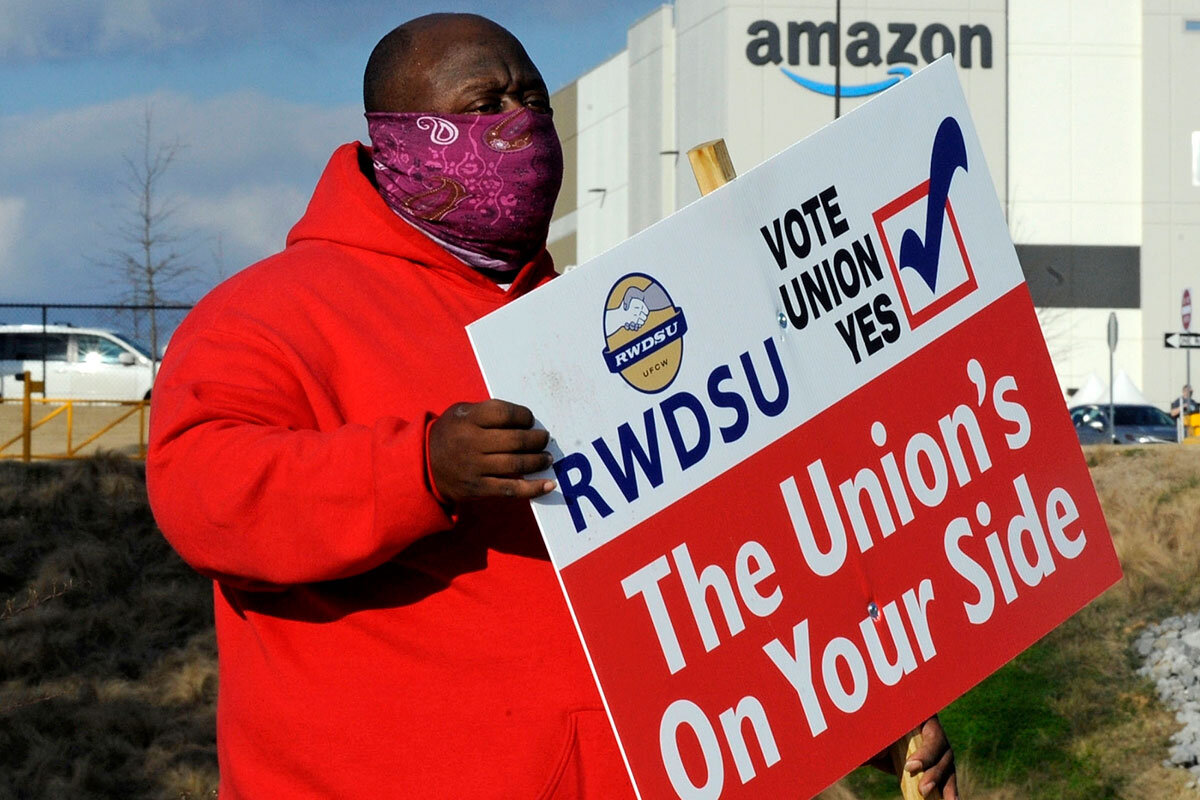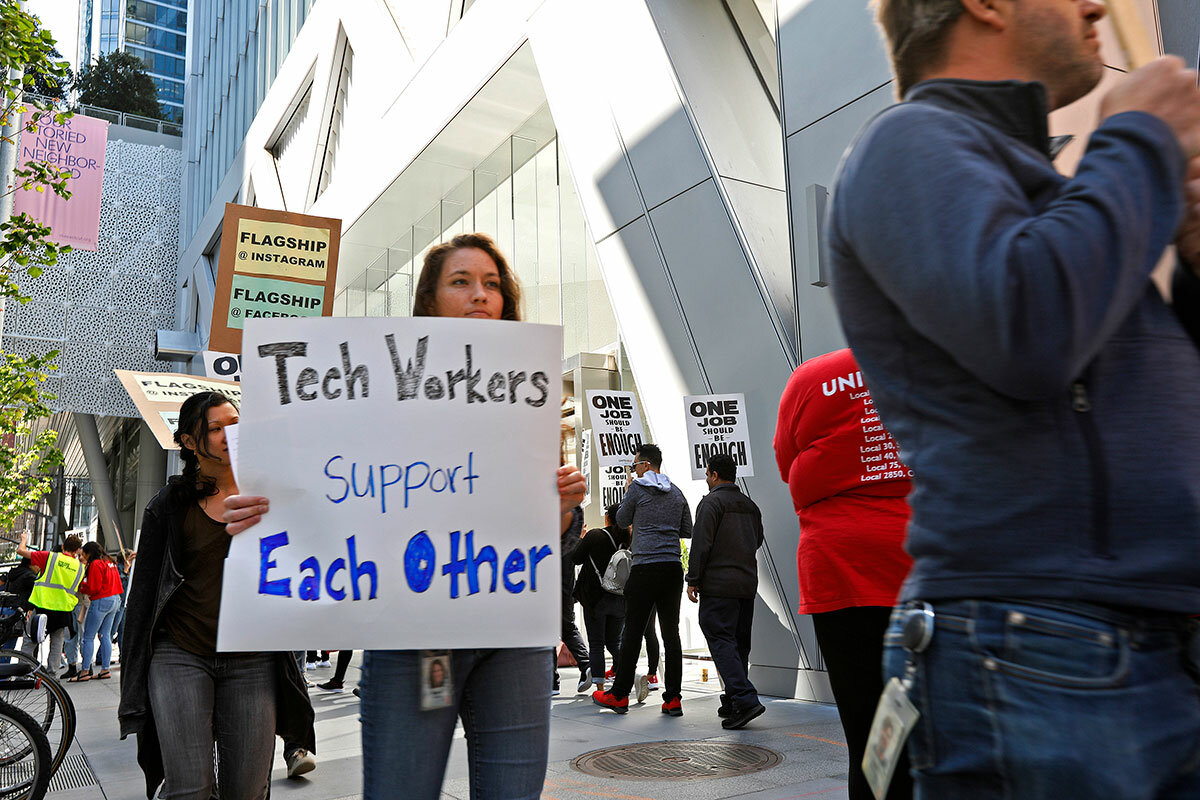From Amazon to Google, tech workers seek unions โ and a voice
Loading...
At an Amazon fulfillment center in Bessemer, Alabama, workers this month began voting on whether to join a union. The issue is not wages โ starting pay is more than double the stateโs minimum wage โ but bathrooms. Workers advocating for the union say the company monitors their productivity so closely that any extra breaks can hinder their advancement.
At Google, employees announced forming a union a month after a respected Black artificial-intelligence researcher said Google fired her for her criticism of bias in its artificial-intelligence program.
And at fundraising platform Kickstarter a year ago, it was the response to a comic book โ โAlways Punch Nazisโ โ that spurred employees to join the Office and Professional Employees International Union.
Why We Wrote This
The tech industry has long held unions at armโs length. But tech workers are increasingly demanding a voice. In the end, they may not need traditional union representation to get it.
High-tech employee activists, who have staged public protests over social issues in recent years, are turning to a traditional form of organization โ unions โ to further their aims. These moves could represent a toehold for the labor movement, which has long wanted to organize the huge, fast-growing tech industry. Or these high-tech movements could bypass traditional unions altogether by embracing an older type of labor organization that relies on moral suasion rather than formal power to make its demands.
What is clear is that high-tech companies cannot ignore employee activism.
โItโs employees seizing control of organizations that they have dedicated their lives to,โ says Mary-Hunter McDonnell, a professor at the University of Pennsylvaniaโs Wharton business school in Philadelphia. They donโt have a say over most corporate decisions or even their own pay. โAnother way to try to influence employeesโ outcomes is to fight for a voice in the companyโs values, especially in this world where companies have such a central role.โ
The movement has the potential to flourish during the pro-labor Biden administration now in place.
Seizing the moment
โIn the last four years, the United States has faced unprecedented social unrest over racial, socioeconomic, and political issues and events,โ warned Littler Mendelson P.C., a labor law firm representing employers, in . โActivism on these subjects is at an all-time high, and it is manifesting itself in the workplace as never before.โ
Thereโs an irony that some of the best compensated employees, working for some of the most progressive employers, feel the need for a union. The tech industry has some of the most outspoken and in many ways liberal leaders in big business. That hasnโt stopped these highly paid workers from speaking out. It even may have encouraged it, some labor experts say.
โEmployers will need to build upon engagement and acknowledge and embrace employee activism,โ said public relations company Weber Shandwick in a 2014 report. Already back then, a third of companies encouraged workers to use social media to share news about their work or their employer, the report found. Since then, the corporate outlook on employee activism has become more tempered.
โEmployee advocacy is here to stay,โ says Kate Bullinger, president of United Minds, a consultancy within Weber Shandwick that focuses on organizational transformation and leadership. โItโs a positive in many waysโ for companies who use activist employees to promote the company and attract top-notch recruits, she adds. โBut weโve also seen the flip side of that.โ
In 2018, thousands of employees petitioned Google to drop a defense contract and, later that year, some 20,000 employees staged a global walkout to protest Googleโs handling of sexual harassment claims. That was the same year that the company dropped โDonโt be evilโ from its code of corporate conduct.ย
And its software engineers donโt seem afraid of losing their jobs, which average , according to Glassdoor. โTech workers are irreplaceable and they know it,โ says Jerry Davis, a professor of management and organizations at the University of Michiganโs Ross School of Business. โIf you get fired from Google, you can move down the street to Facebook, to Palantir, or to DoorDash.โ
Generational shift
The sector also boasts a young workforce whose outlook represents a generational change.ย
During the financial crisis of 2008, these young people saw โtheir own families lose their homes or their friendsโ families losing homes,โ says Toby Higbie, a professor of history and labor studies at the University of California, Los Angeles. โThey saw all that ripped away and realized that [organizing] was the only way to advance their own interests.โ
As tech corporations go, Kickstarter had the bona fides as a progressive voice. It was a public benefit corporation, which meant its charter put positive social outcomes on par with profits. The New York company had come out against the anti-transgender bathroom law in North Carolina. But in 2018, when the right-wing Breitbart news site reported that the company was violating its terms of service with a fundraising campaign for a satirical comic book called โAlways Punch Nazis,โ Kickstarter decided to take down the campaign. When employees protested, the company reversed its decision. But tensions between some employees and management rose, and a year ago, workers voted to unionize.
At high-tech giant Amazon, the labor struggle is different. Instead of its high-paid engineers, some 5,800 workers who pick, pack, and ship out goods to customers are focused squarely on working conditions. Some workers say theyโre tracked so closely that a run to the bathroom can make them miss their quota, which can cut their pay and ultimately hold up advancement. Amazon, which says it gives workers extra time for bathroom runs and two 30-minute breaks per shift, is pushing hard to convince the workers they donโt need a union.
Amazon has unsuccessfully tried to delay the vote and brought in a law firm to fight the union. Workers say theyโre called in for frequent information sessions where company officials point out the downsides of the Retail, Wholesale and Department Store Union. Even in the bathrooms, workers say, there are anti-union flyers.
Many corporations have employed such tactics, with increasing success, to fend off organizing campaigns. In fact, the labor movementโs lack of success in organizing using traditional methods is one reason tech workers are gravitating to the minority union, which is an even older model of signing up workers, says Professor Higbie. All unions start out as minority unions, until they are ratified by a majority of workers. The reason that the newest generation of workers is returning to it stems from the increasing powerlessness of labor law to protect unions from corporate power.
Minority unions canโt engage in collective bargaining for better pay or benefits. And with only about 800 members, the Google union is a long way from organizing Googleโs more than 100,000 workers, even with the sponsorship of a major union, the Communications Workers of America. What minority unions can do is become a voice for employees, including on social issues.ย
Two days after its Jan. 4 launch, the Alphabet Workers Union (named after Googleโs parent company) issued a statement condemning the mob attack on the Capitol and taking on Alphabet-owned YouTube for not shutting down then-President Donald Trumpโs account. Five days later, Google suspended Mr. Trumpโs YouTube account.
Social media has made organizing cheap and easy and swift. โIt has allowed workers to have more time to communicate, to have discussion and debate,โ says Steve Zeltzer, a San Francisco-based labor journalist who produces KPOOโs WorkWeek Radio. โThatโs a revolution.โ
Who will thrive in this new organizing era: the minority union or the traditional one? โWeโll see both,โ he says.






